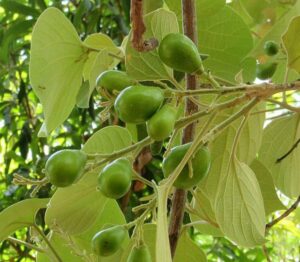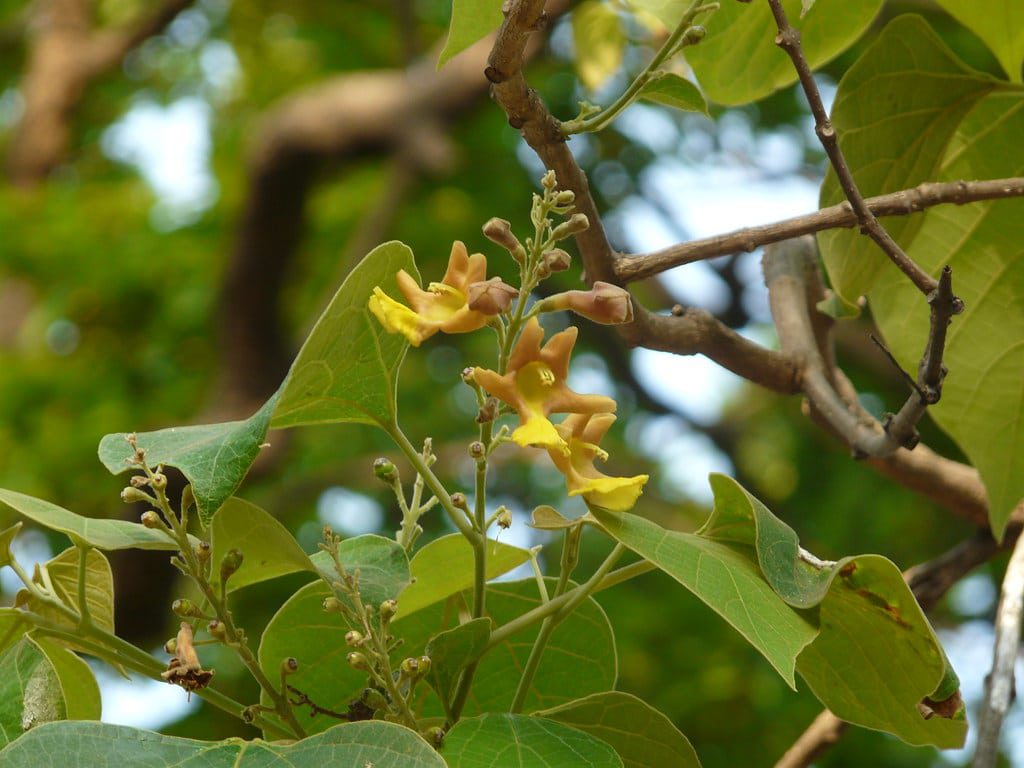Herb
Gambhari (Gmelina arborea) Herb Ayurvedic Overview
Gambhari consists of dried, mature root bark of Gmelina arborea Roxb. (Fam. Verbenaceae). The tree is about 18 m high, with a clear bole of 6-9 m and a circumference of 1.5-2.1 m. Gmelina arborea tree is native to Asia and is found in Myanmar, Sri Lanka, Bangladesh, Thailand, etc. Gambhari roots stem bark, stem, leaves, fruit, flowers are used for medicinal purposes in India since ancient times. Its uses are also mentioned in the classical texts of Ayurveda.
Gambhari effectively manages cough, fever, constipation, dyspepsia, heart diseases, nervous disorders, piles, burning sensation, intestinal parasites. The bark acts as laxative, stomachic, anthelmintic, antipyretic, used in burning sensation, rheumatoid fevers, hemorrhoids, etc.
Table of Contents
Scientific Classification of Gambhari (Gmelina arborea):
- Kingdom: Plantae
- Subkingdom: Tracheobionta
- Superdivision: Spermatophyta
- Class: Magnoliopsida
- Subclass: Asteridae
- Order: Lamiales
- Family: Verbenaceae (Verbena family, important timber plants such as teak belong to this family)
- Genus: Gmelina L. (gmelina)
- Species: Gmelina arborea Roxb.
Gambhari (Gmelina arborea) Synonyms:
- Assamese: Gamari, Gomari
- Bengali: Gambhar, Gamar, Gumar, gumbar
- English: Candhar Tree, Candahar tree, Coomb tree, Cashmeri teak, Coomb Teak, Gamari, White Teak
- Gujrati: Shivan
- Hindi: Gamari, Gambari, Gambhar, Gamhar, Gumbhar, Kambar, Kambhar, Khambhari, Khammara, Kumar, Kumbhar, Sewan, Shewan, Shiwan
- Kannada: Shivanigida, Shivani, Kashmiri, Shivanimara, Shivane, Kumbala mara, Shewney, kuli
- Kashmiri: Kashmari
- Malayalam: Kumizhu, Kumpil, Kumalu, Kumbil, Kumizhu
- Marathi: Shivan, Shewan
- Oriya: Gambhari
- Punjabi: Gumhar, Kumhar
- Tamil: Kumishan, Kumizhan, Gumadi, cummi
- Telugu: Peggummudu, Peggummadi, Gumudu, Pedda-gumudu, Gumar-tek, pedda-gomru, tagumuda
- Nepal: Gambari
- Lepcha: Numbor
- Garo: Bolkobak
Gambhari (Gmelina arborea) Description:
 a) Macroscopic: Root: Gambhari (Gmelina arborea) roots occur in pieces with secondary and tertiary branches. The root pieces are nearly cylindrical with an uneven surface, greyish brown, brittle, and predominant in woody portion.
a) Macroscopic: Root: Gambhari (Gmelina arborea) roots occur in pieces with secondary and tertiary branches. The root pieces are nearly cylindrical with an uneven surface, greyish brown, brittle, and predominant in woody portion.
Root bark: The mature root bark is yellow when fresh and is dry, curved, and channeled. The external surface rugged due to ridges, vertical cracks, fissures, and numerous lenticels. The fracture is short and granular, taste, mucilaginous, sweetish with a slight bitterness.
b) Microscopic: The transverse section of the Gambhari root shows 6-8 layers of cork cells. The secondary cortex includes primary and secondary phloem, out of which about two-third consisting of wood. The cork is brownish, and cells are arranged in a tangential direction and broken at the upper layers. The cortex is characterized by thin-walled parenchymatous cells with starch grains and resin ducts present in abundance throughout the cortex. The cells of the cortex contain calcium oxalate crystals and oil globules. The primary phloem consists of sieve tubes with parenchyma, soft bast fibers, ray cells, and companion cells.
The wood is consists of medullary rays and simple pitted wood parenchyma, and the cells are mainly composed of tracheids and vessels. The inner wood contains a significant portion of fibers with a few vessels. The vessels are multiple in numbers and form a ring near the periphery xylem cylinder. The lumen of vessels is large, and the dimension is 130-250 µ by 50-100 µ.
Identity, Purity, and Strength of Gambhari (Gmelina arborea):
- Foreign matter Not more than 2 percent, Appendix 2.2.2.
- Total Ash Not more than 5 percent, Appendix 2.2.3.
- Acid-insoluble ash Not more than 0.3 percent, Appendix 2.2.4.
- Alcohol-soluble extractive Not less than 7 percent, Appendix 2.2.6.
- Water-soluble extractive Not less than 20 percent, Appendix 2.2.7.
Chemical Constituents of Gambhari (Gmelina arborea):
The main chemical constituents are quercetin, hentriacontanol, Luteolin, apigenin, betasitosterol. The root and root bark is rich in n-octacosanol and b-sitosterol, arboreal, Yellow viscid oil, gmelinol, hentriacontanol, isoarboreal. The stem contains lignans and the fruit is rich in Gmelofuran, Gmelinol, Hentriacontanol, Beta-Sitosterol, Butyric acid, Tartaric acid, Alkaloid, Resin and Saccharine.
Ayurvedic Properties and Action of Gambhari (Gmelina arborea):
- Rasa: Tikta, Kashaya
- Guna: Guru
- Virya: Ushna
- Vipaka: Katu
- Karma: Shoth hara, Deepan, Bhedan, Pachan, Vishaghan, Medhya, Jwarahara.
Ayurvedic Formulation made by Gambhari (Gmelina arborea):
The primary formulation of Gambhari is Dashmoolarishta, Mahatriphala Ghrita, Dashmool Kshayam, Dashmoola Taila.
Therapeutic Uses of Gambhari (Gmelina arborea):
The main indications of Gambhari are Deepan, Pachan, Shramhara, Dahahara, Artijit, Vrishya, Mutravibhandha, Shukrala, etc.
Dose of Gambhari (Gmelina arborea):
20-30 g of the drug for decoction.
Reference:
Ayurvedic Pharmacopeia of India.


